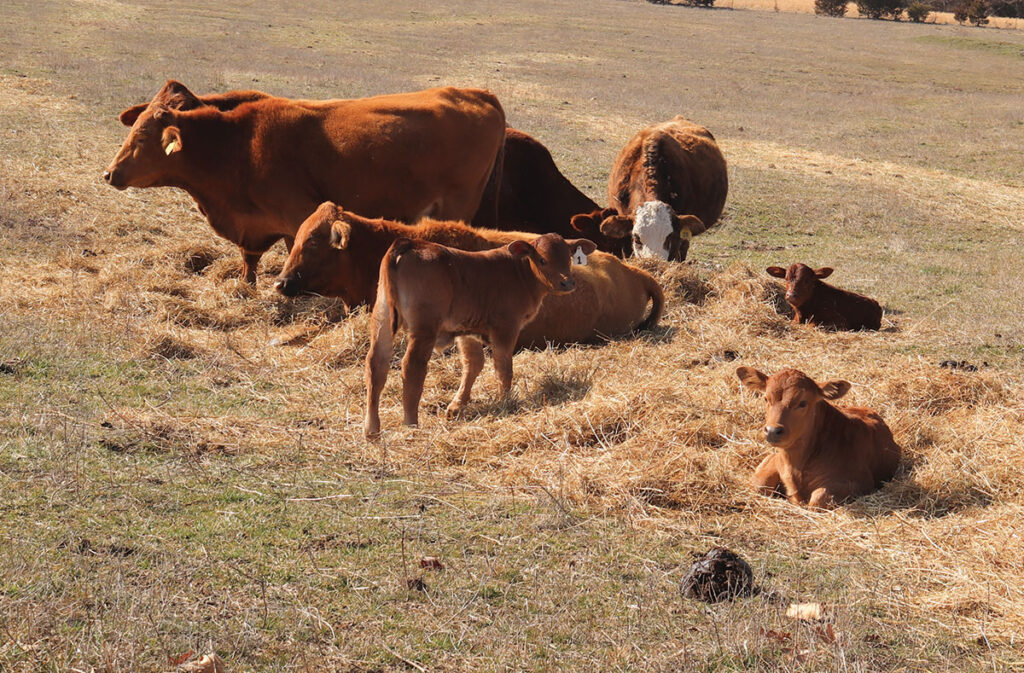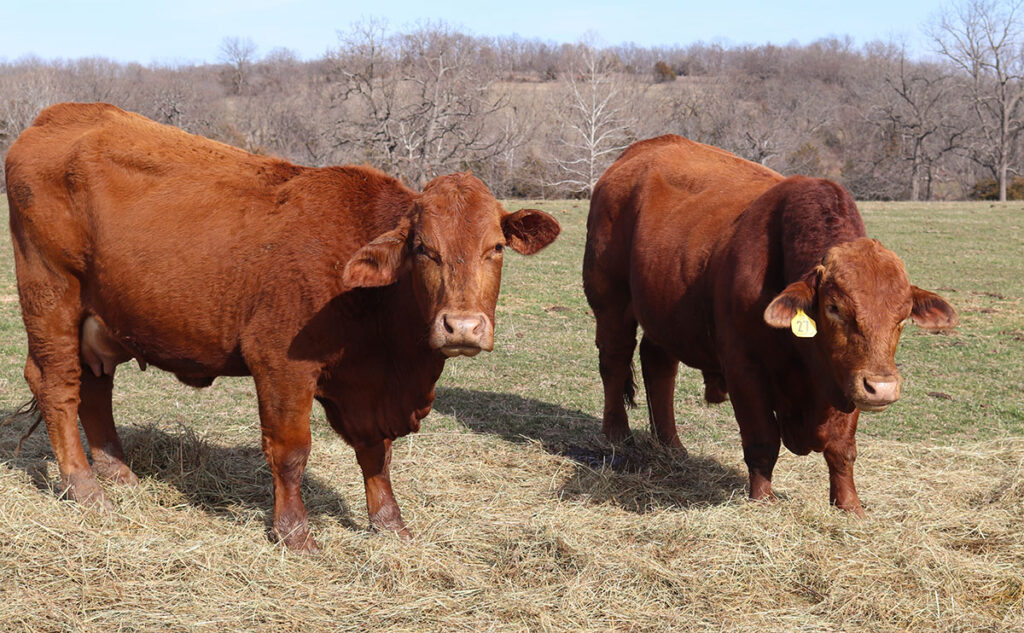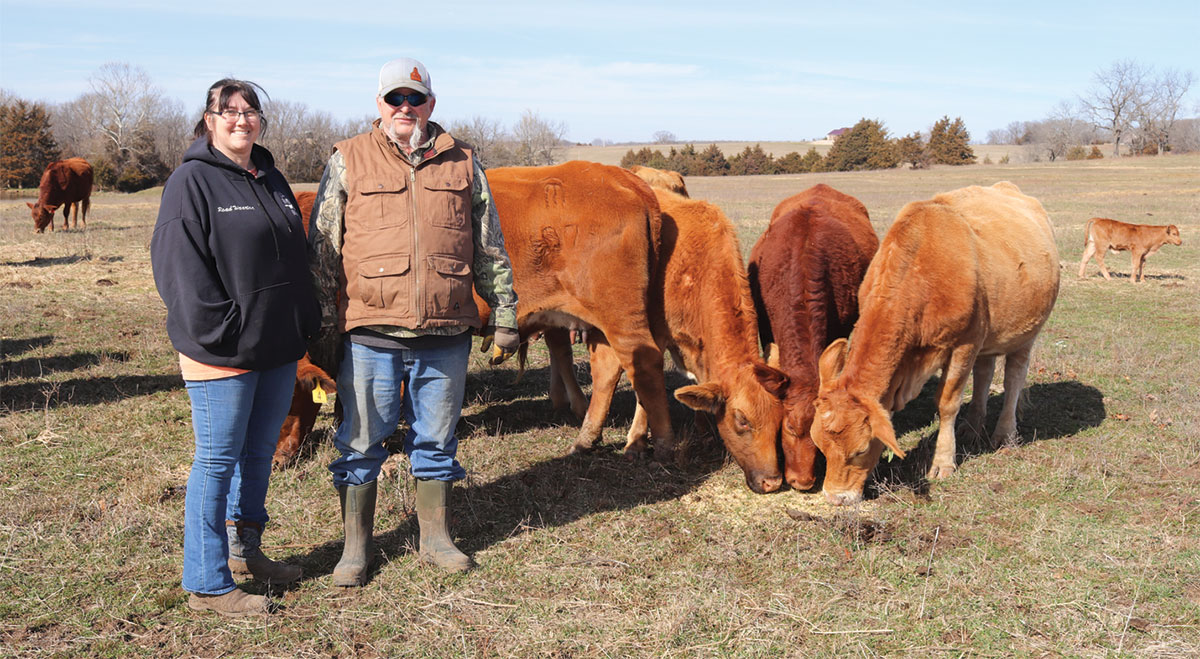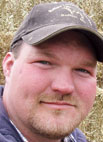
Marilynn Teague and Jimmie Chastain ventured into registered Beefmasters six years ago
DUNNEGAN, MO. – Nestled in Polk County, Mo., is a small, almost forgotten cemetery – “Pickel Cemetery.”
A small tributary near the cemetery, which dates back to the Civic War area, is dubbed Pickle Creek by the owners of the land in which it crosses. When they began looking for a catchy name for their budding registered cattle operation, they looked no further than their farm.
Pickle Creek Beefmasters began about six years ago near Dunnegan, Mo. Marilynn Teague and Jimmie Chastain raised Angus and Charolais-influenced cattle for several years, but when Marilynn graduated nursing school, she wanted to reward herself by purchasing registered cattle. Jimmie’s family has been on the Chastain Ranch since 1939, and Pickle Creek Beefmasters is a part of the operation.
“We were at a sale in Springfield, Mo., and decided we liked big butts,” Marilynn said of the Beefmaster breed.
The couple started their endeavor with Beefmaster bulls added to the commercial herd and eventually added a registered heifer. Since then, their registered herd has grown to about 50 primarily red Beefmasters, and the couple is actively involved in six state, regional and national Beefmaster organizations. Both have held or currently hold leadership positions in those organizations.
The six essential traits outlined by breed founder Tom Lasater — weight, conformation, milk production, fertility, hardiness and disposition — drew the couple to Beefmasters. The breed was developed from Hereford, Shorthorn and Brahman cattle.
“We collected cattle from 10 states to start our breeding herd,” Jimmie said. “We aren’t buying $40,000 heifers, but we get some top-of-the-line genetics.”
Once they began adding Beefmaster females to their herd, Marilynn said they incorporated an AI program to build their genetic profile. They typically AI heifers and rotate between AI and natural service.
The majority of the Pickle Creek Beefmasters-Chastain Ranch herd is spring calving, with a few stragglers in the fall.
“We like the spring calves because that coincides with the sales,” Jimmie said. “We have spring sales, and those calves need to be a year old for the futurities; it just works out better. Some production sales cater to earlier-than-spring calving, so we bred some this year to see if we can compete in another feed test in Texas. Those had to be January calves, and we usually have February calves.
“When you enter the feed tests and the yearling futurities, you want them to be as early in the window as you can so they will be bigger. I had a great bull, and it should be the number one bull, but there were two bulls bigger.”
Marilynn explained bulls in feed tests are typically kept on grass for two to three months, then put on feed.
“They look at the daily rate of gain on grass, then on feed, then an overall order is set by a group of judges,” she said.
Bulls raised by Marilynn and Jimmie have competed in three bull sales so far, and they had the top bull at an Arkansas sale last year. The number of bulls in a test or included in a futurity and the number each breeder may enter is determined by each breed association.
This year, Marilynn and Jimmie are also entering heifer futurities.
Participating in feed tests and futurities is a marketing tool, but the couple would rather sell animals directly from the farm.
“We like the competition and seeing how our bulls measure up, but you can’t have 10 number one bulls,” Jimmie said.
Marilynn and Jimmie are selective when evaluating their bulls, and both commercial and registered bulls must meet specific standards, including eye appeal and structure, to remain possible herd sires. Any bull not meeting the criteria is castrated. The couple also scans each animal to obtain a ribeye size and intramuscular fat.
“They have to be tame,” Marilynn added. “Most of the time, I work them by myself. We start looking at them right before weaning to see how they are growing, how they are developing.”

Marilynn and Jimmie have retained most of their females to build their registered herd. Percentage females or heifers born into their commercial herd are sold as replacement heifers.
“We have sold more heifers this year than we ever have,” Jimmie said. “Right now, we have a Beefmaster bull with the commercial herd. Last spring, I sold my last Charolais bull. I still sell a certain amount of Charolais bulls, and I will probably put a Charolais bull back in with those Charolais cows. If not, we will keep a Beefmaster with them.”
Utilizing a Beefmaster bull on a commercial herd, Marilynn said, produces heavier calves for those looking the terminal market.
Females retained in the Pickle Creek Beefmaster-Chastain Ranch operation, or any females brought in as breeding stock, must meet Marilynn and Jimmie’s high standards.
“They have to have that eye appeal and docility,” Marilynn said. “They have to come from good mommas, and we always pelvic score them. Getting that pelvic measurement has really helped us improve. We also watch birthweights. When a calf hits the ground, you can tell if they are going to be a rock star or a dud. When we go to a sale, I get a catalog, he gets and catalog, and I build a spreadsheet.”
Jimmie said Marilynn looks at numbers and he evaluates the appearance, but they are usually on the same page.
“More times than not, we will come up with the same cows,” Jimmie said. “They might not be in the same order, but our top eight out of 10 will be the same.”
Heifers enter the Pickle Creek-Chastain Ranch breeding program at about 14 to 15 months of age.
“Most Beefmaster breeders want heifers that will calve by the time they are 2,” Marilynn added.

Because they want animals that stick to the six essentials of the Beefmaster breed, Marilynn and Jimmie will not keep a heifer that does not breed on the first breeding cycle, and those animals will not be sold as replacement animals.
Jimmie added that the Lasaters had a philosophy that any cow that could not raise a calf — be it her fault or the fault of Mother Nature — the cow was culled.
“They are supposed to be disease resistant, really resilient and raise a calve in some of the toughest environments, so if she doesn’t wean a calf, she is gone,” Jimmie said.
In the commercial herd, which is about 110 head, Jimmie said their heifer customers appreciate the quality of the Beefmaster-cross heifers.
“I had a load to go Kansas last week,” he said. “I even have a market for the crossbred bulls.”
Cows receive few inputs, other than minerals, grass and hay, which they produce on the farm or is grown locally. The herds will receive an occasional treat of feed. Marilynn said heavily fed cattle tend to develop feet and fertility issues.
Initially, Marilynn and Jimmie leaned more toward a moderate frame, wide-bodied animal, which is more in line with the foundation breeding of Beefmasters. As the years went on and the breed evolved, a larger-framed Beefmaster developed, and the couple added a little more frame. They do not strictly follow either line but instead found a good mix.
“We want to raise the type of cattle people want,” Jimmie said. “We could chase that bigger frame and only buy those big cows and spend a ton of money feeding them, so we are going to do our thing.”
Calves are weaned at around 205 days and occasionally receive creep feed, usually a low-grade commodity feed, prior to weaning. As they grow, they remain on a commodity mix. Cattle going to sales or futurities receive a higher-quality show ration the last 30 or 40 days to “slick them up.”
In addition to seedstock, Marilynn and Jimmie have a beef program, selling whole, halves and quarters. They processed close to 30 head last year, but they may reduce that number this year because of feed and processing costs.
Marilynn and Jimmie plan to continue building their registered herd, and maintain their commercial herd, which provides a steady income stream.
“I am really happy about how far we have come and with our cattle, and with Beefmasters,” Marilynn said, adding that they plan to continue to seek out genetic lines that work well for them in the Ozarks.”







